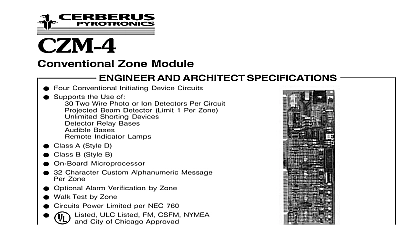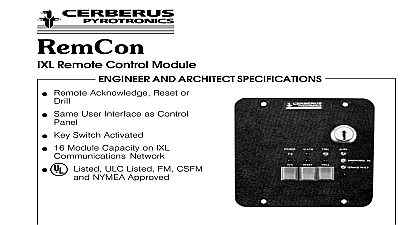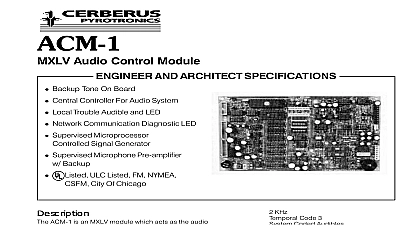Cerberus Pyrotronics CZM-1 Remote Conventional Zone Module 5006

File Preview
Click below to download for free
Click below to download for free
File Data
| Name | cerberus-pyrotronics-czm-1-remote-conventional-zone-module-5006-8349761205.pdf |
|---|---|
| Type | |
| Size | 1.04 MB |
| Downloads |
Text Preview
CZM 1 Conventional Zone Module AND ARCHITECT SPECIFICATIONS Provides Distributed Conventional Zoning One Conventional Initiating Device Circuit Connects to MXL ALD Circuits Powers Up to 15 Series 3 Smoke Detectors Unlimited Shorting Devices per Circuit Class A Style D or Class B Style B Latching Alarm LED 32 Character Custom Alphanumeric Message Alarm Verification Capability Walk Test Capability No Mechanical Address Programming Required Includes Metal Cover Plate Circuits Power Limited per NEC 760 Listed ULC Listed CSFM NYMEA Approved FM Approved as Intrinsically Safe with ISI 1 CZM 1 is an intelligent device which connects to an loop and provides one remote conventional initiating circuit This circuit can power up to 15 Series 3 two ionization or photoelectric smoke detectors It can also listed alarm causing shorting devices such as switches thermal detectors and manual station Each CZM 1 can be assigned a 32 character custom message It also includes a latching alarm LED which is visible through the cover plate CZM 1 supports both Class A Style D or Class B B wiring It includes a trim cover plate CZM 1 occupies one address on the ALD circuit It not require any mechanical address programming It programmed and tested using the Cerberus Pyrotronics Programmer Tester ISI 1 an Intrinsically Safe FM Approved Isolation now makes it possible to convert a conventional into an Intrinsically Safe zone of CZM 1 modules allows a system to be designed a combination of intelligent and conventional devices a substantial reduction in wire Intelligent devices can employed in those areas requiring pin point annuncia as well as analog detection features Common or other can be protected using conventional zoned detection to the CZM 1 circuits This method of conventional zoning through the use of modules to intelligent circuits can result in a substantial cost savings ISI 1 an Intrinsically Safe FM Approved Isolation now makes it possible to convert a conventional into an Intrinsically Safe zone The ISI 1 is designed to with a CZM 1 and in conjunction with the MXL and systems detectors that are approved to use in Class I Div I with the ISI 1 are the DI 3IS Ion Detectors and the and S 122 Flame Detectors A maximum of ten 10 detectors are allowed and a maximum of five 5 or S 122 Flame Detectors are allowed the ISI 1 is a passive device no power is required mechanical non energy storing shorting devices as the MS 51 Manual Station may be used In addi S 121 and S 122 are also approved for use in Class II Class III Groups E F and G guidance on installation see ANSI ISA RP 12.6 of Intrinsically Safe Instrument Systems in Class 1 Locations For DI 3IS information see the DI 3 installation instructions P N 315 081943 For S 121 S 122 information see the installtion instructions 315 085258 NUMBER Analog Loops CZM 1 communicates with the MXL via the MXL loops which may be on the MMB 1 or the ALD 2 module The analog loops may be wired A or Class B 24 Volt DC Power CZM 1 derives its power from the CZM 1 power on the MMB 1 This power is available on TB5 of MMB 1 on terminals 9 12 The power may be wired Class A or Class B Since the CZM 1 monitors the at its screw terminals it is possible to star or T tap power connection this can be done only in the Class configuration The UL identifiers for compatibility are the same as the names specified below Compatible Cerberus detectors are Instructions 315 081943 315 081943 315 086590 315 086591 315 086592 315 086441 315 086545 STYLE D CALSS A INITIATING CIRCUIT WIRING and Architect Specifications CZM 1 Intelligent Remote Conventional Zone Module connect to an MXL ALD intelligent analog detection and provide one 1 conventional initiating device This circuit shall support the use of up to 15 Series 3 wire smoke detectors and an unlimited number of alarm causing shorting devices such as waterflow thermal detectors manual stations etc The shall support either Class A Style D or Class B B wiring Its circuits shall be supervised for open and ground fault Faults and alarm shall be reported the MXL display s with a 32 character custom alphanu message Through the use of the MXL degrade capability the CZM 1 shall be capable of reporting a alarm condition even in the event of main processor or loss of network communication CZM 1 shall be powered by a power limited 24 VDC by the MXL or PSR 1 remote network supplies CZM 1 initiating device circuit shall also be power per NEC 760 CZM 1 shall be equipped with a latching alarm indica LED which is visible through the cover plate CZM 1 shall occupy one address on the ALD 2 modules shall be capable of being programmed to with the alarm verification feature NOTE Shorting shall not be used with the alarm verification The CZM 1 shall be capable of reset through the connected to the CZM 1 shall be capable of being using the Person Walk Test feature CZM 1 shall not require any mechanical address It shall be fully software addressed using the Pyrotronics model FPI 32 Programmer Tester A shall be provided for connection of this programmer CZM 1 shall be Underwriters Laboratories Inc listed Data ELECTRICAL RATINGS Initiating Device Circuit Electrical Ratings Voltage Current Current Resistance VDC max max ohms total EOL devices 4.7K 1 4W P N 140 8201888 All circuits are power limited to NFPA 70 per NEC 760 detector or group of detectors must use a two wire of at least 18 AWG thermoplastic fixture wire en in conduit or 18 AWG limited energy shielded without conduit is permitted by local building CONNECTIONS Initiating Devices CZM 1 supports one zone of initiating devices in Class A or Class B Style D or B configuration to fifteen 2 wire conventional smoke detectors any of those listed in No 4 below may be used unlimited number of shorting devices may be used ANALOG LOOP WIRING CZM 1 POWER TB5 9 12 CZM 1 power is available on TB5 terminals 9 through 12 All wiring must be in accordance with Article 760 of NEC local building codes CZM 1 power is power limited to NFPA 70 per NEC 760 Electrical Ratings VDC 1A max may connect a maximum of 20 CZM 1s to this source You must follow the guidelines below wiring power may be wired Class A as shown in wiring labeled CZM 1 Power Class A Wiring Class wiring can support a maximum of 10 CZM 1s total resistance of 4 ohms max T tapping is not allowed to wiring diagram labeled CZM 1 Power Class B Class B wiring can be used to obtain the of 20 CZM 1s Each Class B wire run can a maximum of 10 CZM 1s 4 ohms max Class B power connections can be used you do not exceed the ratings above 20 CZM max and 4 ohms per run max For example you have four individual Class B power runs for a total 20 devices 6 4 3 and 7 CZM 1s each of the 4 runs exceeding 4 ohms resistance T tapping is allowed the total resistance of all wires does not 4 ohms STYLE B CLASS B INITIATING CIRCUIT WIRING POWER CLASS A WIRING POWER CLASS B WIRING CZM 1 Power TB3 Class A power limited output is provided on TB3 for use the CZM 1 This power is available on TB3 terminals 1 through 4 All wiring must be in accordance with Article 760 or NEC local building codes The power for CZM 1 and PS 5 is power limited to NFPA per NEC 760 Electrical Ratings VDC 2A max may connect a maximum of 40 CZM 1s to the TB3 source Follow the guidelines below when wiring power may be wired Class A as shown in wiring labeled CZM 1 Power Class A Wiring Class wiring can support a maximum of 20 CZM 1s with line resistance of 4 ohms max T tapping is not to wiring diagram labeled CZM 1 Power Class B Class B wiring can be used to obtain the of 40 CZM 1s Each Class B wire run can a maximum of 20 CZM 1s 4 ohms max Class B power connections can be used if you not exceed the ratings above 40 CZM 1s max and ohms per run max For example you could have four Class B power runs for a total of 40 devices example 12 8 6 and 14 CZM 1s with each of the runs not exceeding 4 ohms resistance is allowed provided the total resistance of all does not exc


